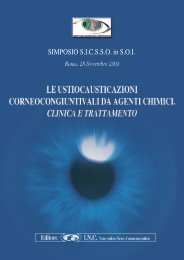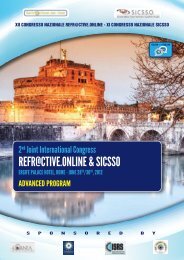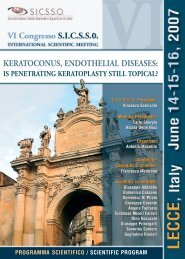1st EuCornea Congress
1st EuCornea Congress
1st EuCornea Congress
Create successful ePaper yourself
Turn your PDF publications into a flip-book with our unique Google optimized e-Paper software.
<strong>1st</strong> <strong>EuCornea</strong> <strong>Congress</strong> venice, 17-19 june 2010<br />
FREE PAPER Abstracts<br />
a safe procedure to prepare a donor endothelial disc of the desired thickness.<br />
It creates a smooth stromal bed and precise side cut to perform endothelial<br />
keratoplasty. Mean Best Corrected Visual Acuity is similar to one reported in<br />
literature after DSAEK, but a higher number of treatments is necessary.<br />
Gatinel, Damien<br />
Proper identification of preoperative forme fruste<br />
keratoconus using elevation topography<br />
D. Gatinel 1 , A. Saad 2<br />
1. Rothschild Foundation, 25 Rue Manin, Paris, France<br />
2. C.E.R.O.C, Paris, France<br />
Purpose: To investigate if elevation topography indices may help detect<br />
suspect corneas and prevent iatrogenic ectasia.<br />
Methods: We retrospectively reviewed data of 178 eyes separated into<br />
4 groups by the Nidek Corneal Navigator (NCN) System of the OPD scan:<br />
normal (N) (n=72), Keratoconus Suspect (KCS) (n=35), Forme Fruste<br />
Keratoconus (FFKC) (Classified as N by the NCN but with a KC in the<br />
fellow eye) (n=40) and Keratoconus (KC) (n=31). Elevation topography<br />
indices, corneal thickness and curvature spatial profile were obtained and<br />
calculated with the Orbscan IIz.<br />
Results: Anterior curvature indices were not significantly different<br />
between the FFKC group and the N group, while the elevation of the<br />
posterior corneal surface was significantly higher in the FFKC and the KCS<br />
group compared to the N group. The gradient of thickness was significantly<br />
higher in the FFKC and KCS group compared to the N group for almost all<br />
the diameter zones. Conclusion: Indices generated from corneal thickness<br />
and curvature measurements over the entire cornea can identify very early<br />
forms of KC undetected by placido topography.<br />
Gatzioufas, Zisis<br />
Biochemical and histopathological findings in Schnyder<br />
corneal dystrophy<br />
Z. Gatzioufas, T. Hager, B. Seitz<br />
Department of Ophthalmology, University of Saarland, Hamburg, Germany<br />
Background/Aim: Schnyder corneal dystrophy (SCD) is a rare<br />
autosomal dominantly inherited corneal disorder affecting the central and<br />
peripheral cornea and is characterized by cholesterol and phospholipid<br />
deposition in corneal epithelium and stroma. Aim of our study was to<br />
investigate the role of oxidative stress in the pathogenesis of SCD and also<br />
to examine certain histopathological features regarding the topographic<br />
localisation of corneal lipid deposition.<br />
Methods: Four corneas from four patients with SCD, who underwent<br />
penetrating keratoplasty (PK), were examined. Immunohistochemistry was<br />
performed using antibodies against the inducible nitric oxide synthase<br />
(i-NOS), the constitutive nitric oxide synthase (e-NOS) and nitrotyrosine<br />
(NT). During PK 15 ml of aqueous humor were aspired from the anterior<br />
chamber and consequently subjected to malondialdehyde-thiobarbituric acid<br />
reactive substances test (MDA-TBARS) for detection of malondialdehyde<br />
(MDA). Corneal specimens from all patients were examined histologically.<br />
Results: Corneas with SCD demonstrated a strong signal for NT and i-NOS<br />
in the epithelium, whereas in normal corneas immunostaining was minimal.<br />
The immunoreactivity pattern for e-NOS was similar in both normal and<br />
SCD corneas. MDA levels in the aqueous humor of the SCD patients were<br />
significantly increased (0.89±0.08 µm/L) compared to control patients<br />
(0.32±0.04 µm/L) (Fisher exact test, p







